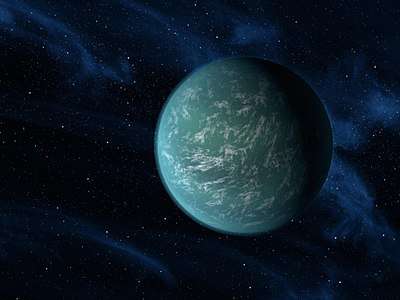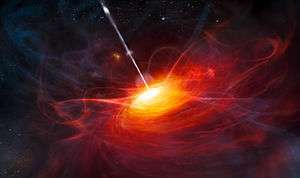WD 0806−661
WD 0806−661 (L 97-3, GJ 3483) is a wide binary system of a white dwarf and a Y-type sub-brown dwarf (designated "B"), located in constellation Volans at 63 light-years from Earth. The companion was discovered in 2011. It has the largest actual (2500 AU) and apparent separation (more than 2 arcminutes) of any known planetary-mass object.
 The right side shows an image taken by ESO's VLT HAWK-I in near-infrared. The white dwarf is marked with an arrow. The left side shows an image taken by the NASA/ESA HST WFC3 also in near-infrared wavelengths. The sub-brown dwarf appears as green pixels (2014) and purple pixels (2015) in an insert. | |
| Observation data Epoch J2000[1] Equinox J2000[1] | |
|---|---|
| Constellation | Volans |
| Right ascension | 08h 06m 53.736s[1] |
| Declination | −66° 18′ 16.74″[1] |
| Characteristics | |
| Spectral type | DQ4.2[2][3] + Y1[4] |
| Apparent magnitude (B) | 13.74[5] / - |
| Apparent magnitude (V) | 13.71[5] / - |
| Apparent magnitude (R) | 13.64[5] / - |
| Apparent magnitude (I) | 13.60[5] / - |
| Apparent magnitude (J) | 13.704 ± 0.023[1] / ~25.42[6] |
| Apparent magnitude (H) | 13.739 ± 0.025[1] / ~25.29[6] |
| Apparent magnitude (K) | 13.781 ± 0.043[1] / - |
| Astrometry | |
| Proper motion (μ) | RA: 335.547 ± 0.044[7] mas/yr Dec.: -288.888 ± 0.041[7] mas/yr |
| Parallax (π) | 51.9342 ± 0.0195[7] mas |
| Distance | 62.80 ± 0.02 ly (19.255 ± 0.007 pc) |
| Absolute magnitude (MV) | 12.30[5] / - |
| Details | |
| Component A | |
| Mass | 0.58 ± 0.03[5] M☉ |
| Surface gravity (log g) | 8.00 ± 0.05[5] cgs |
| Temperature | 10205 ± 390[5] K |
| Age | 1.5–2.7[6] Gyr |
| Component B | |
| Mass | 7–9[6] MJup |
| Surface gravity (log g) | 4.2–4.3[6] cgs |
| Temperature | 325–350[6] K |
| Metallicity | <0[6] |
| Position (relative to A) | |
| Component | B |
| Angular distance | 130.2 ± 0.2″ [8] |
| Position angle | 104.2 ± 0.2° [8] |
| Observed separation (projected) | 2500 AU [8] |
| Other designations | |
| Database references | |
| SIMBAD | data |
| Extrasolar Planets Encyclopaedia | data |
Discovery
Component B was discovered in 2011 with Spitzer Space Telescope. Its discovery paper is Luhman et al., 2011. At the time of its discovery, WD 0806−661 B was the coldest "brown dwarf" that has ever been found, with a temperature of only 27–80 °C, which is similar to some hot areas of Earth.[8]
The companion
The secondary is a sub-brown dwarf with a mass between 7 and 9 MJ and a temperature between 325–350 Kelvin (52-77 °C; 125-170 °F).[6] The spectral type of this object was estimated to be Y1 as it was detected with the Hubble Space Telescope in near-infrared wavelengths.[4] The color of this object suggest that it is metal-poor. The metal-poor composition of the companion cloud explain the DQ spectral type of the primary white dwarf.[6] Hydrogen-deficient AGB stars might evolve into DB white dwarfs and then into DQ white dwarfs as they cool down.[12]
See also
References
- "GJ 3483 -- White Dwarf". SIMBAD. Centre de données astronomiques de Strasbourg. Retrieved 2012-06-19.
- Holberg, J. B.; Sion, E. M.; Oswalt, T.; McCook, G. P.; Foran, S.; Subasavage, John P. (2008). "A New Look at the Local White Dwarf Population". The Astronomical Journal. 135 (4): 1225–1238. Bibcode:2008AJ....135.1225H. doi:10.1088/0004-6256/135/4/1225.
- Sion, Edward M.; Holberg, J. B.; Oswalt, Terry D.; McCook, George P.; Wasatonic, Richard (2009). "The White Dwarfs Within 20 Parsecs of the Sun: Kinematics and Statistics". The Astronomical Journal. 138 (6): 1681–1689. arXiv:0910.1288. Bibcode:2009AJ....138.1681S. doi:10.1088/0004-6256/138/6/1681.
- Leggett, S. K.; Morley, Caroline V.; Marley, M. S.; Saumon, D. (January 2015). "Near-infrared Photometry of Y Dwarfs: Low Ammonia Abundance and the Onset of Water Clouds". The Astrophysical Journal. 799 (1): 37. arXiv:1411.2020. Bibcode:2015ApJ...799...37L. doi:10.1088/0004-637X/799/1/37. ISSN 0004-637X.
- Giammichele, N.; Bergeron, P.; Dufour, P. (2012). "Know Your Neighborhood: A Detailed Model Atmosphere Analysis of Nearby White Dwarfs". The Astrophysical Journal Supplement. 199 (2): 29. arXiv:1202.5581. Bibcode:2012ApJS..199...29G. doi:10.1088/0067-0049/199/2/29.
- Leggett, S. K.; Tremblin, P.; Esplin, T. L.; Luhman, K. L.; Morley, Caroline V. (June 2017). "The Y-type Brown Dwarfs: Estimates of Mass and Age from New Astrometry, Homogenized Photometry, and Near-infrared Spectroscopy". The Astrophysical Journal. 842 (2): 118. arXiv:1704.03573. Bibcode:2017ApJ...842..118L. doi:10.3847/1538-4357/aa6fb5. ISSN 0004-637X.
- Gaia Collaboration (2018-08-01). "Gaia Data Release 2 - Summary of the contents and survey properties". Astronomy & Astrophysics. 616: A1. arXiv:1804.09365. Bibcode:2018A&A...616A...1G. doi:10.1051/0004-6361/201833051. ISSN 0004-6361.
- Luhman, K. L.; Burgasser, A. J.; Bochanski, J. J. (2011). "Discovery of a Candidate for the Coolest Known Brown Dwarf". The Astrophysical Journal Letters. 730 (1): L9. arXiv:1102.5411. Bibcode:2011ApJ...730L...9L. doi:10.1088/2041-8205/730/1/L9.
- Luhman, K. L.; Burgasser, A. J.; Labbé, I.; Saumon, D.; Marley, M. S.; Bochanski, J. J.; Monson, A. J.; Persson, S. E. (2012). "Confirmation of One of the Coldest Known Brown Dwarfs". The Astrophysical Journal. 744 (2): 135. arXiv:1110.4353. Bibcode:2012ApJ...744..135L. doi:10.1088/0004-637X/744/2/135.
- "WD 0806-661B -- Brown Dwarf (M<0.08solMass)". SIMBAD. Centre de données astronomiques de Strasbourg. Retrieved 2012-06-19.
- Rodriguez, David R.; Zuckerman, B.; Melis, Carl; Song, Inseok (2011). "The Ultra Cool Brown Dwarf Companion of WD 0806-661B: Age, Mass, and Formation Mechanism". The Astrophysical Journal Letters. 732 (2): L29. arXiv:1103.3544. Bibcode:2011ApJ...732L..29R. doi:10.1088/2041-8205/732/2/L29.
- Althaus, L. G.; Serenelli, A. M.; Panei, J. A.; Córsico, A. H.; García-Berro, E.; Scóccola, C. G. (May 2005). "The formation and evolution of hydrogen-deficient post-AGB white dwarfs: The emerging chemical profile and the expectations for the PG 1159-DB-DQ evolutionary connection". Astronomy and Astrophysics. 435 (2): 631–648. arXiv:astro-ph/0502005. Bibcode:2005A&A...435..631A. doi:10.1051/0004-6361:20041965. ISSN 0004-6361.


.jpg)